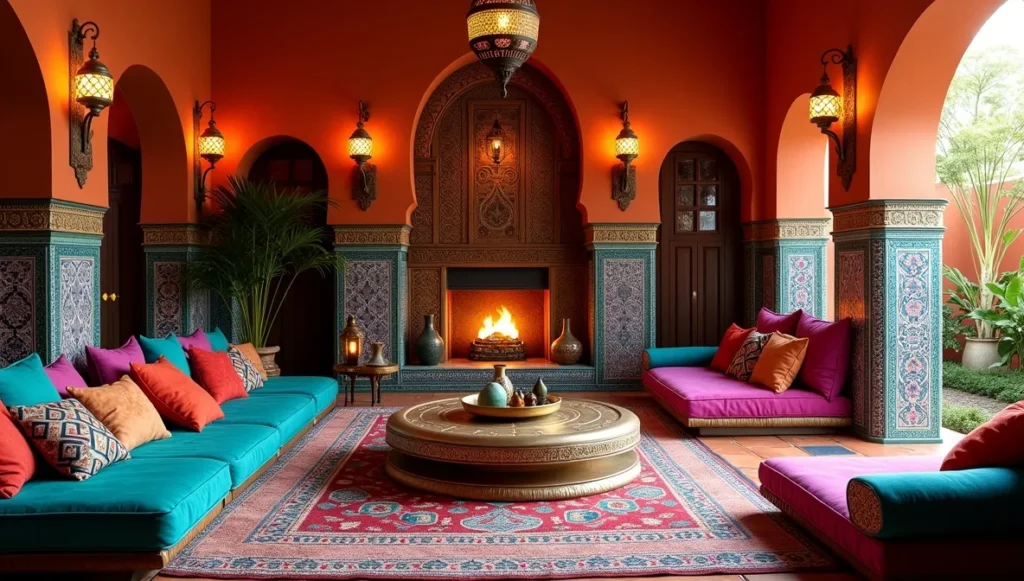- Moroccan Interior Design: How I Learned to Stop Worrying and Love Bold Colors - September 4, 2025
- Modern Indian Design Style: When Tradition Meets Today’s Living - September 3, 2025
- Twenty Years of Getting Indian Traditional Design Wrong (And Finally Right) - September 3, 2025
Table of Contents
So there I was, standing in this courtyard in Marrakech, jaw on the floor. Every wall covered in these crazy intricate tiles, brass lanterns hanging everywhere, and somehow it all worked together perfectly. My American brain kept thinking “this should look like a hot mess” but instead it felt like the most beautiful, calming place I’d ever seen.
That trip changed how I think about decorating completely. Turns out you can use way more color and pattern than we’re taught, as long as you know a few tricks. I’ve been back to Morocco five times now, and I’ve helped tons of clients bring this vibe home without making their houses look like theme restaurants.
Why Moroccan Design Hits Different
Most home decor plays it safe with beige and gray. Moroccan style says “life’s too short for boring rooms.” But here’s the thing – it’s not random chaos. There’s actually a system to all that beautiful craziness.
The style comes from this amazing mix of cultures – Berber tribes, Islamic architecture, French colonials, Jewish artisans – all throwing their best ideas into one pot. What you get feels both exotic and somehow familiar, fancy but totally livable.
The magic happens in layers. Rich colors, intricate patterns, tons of texture, warm lighting that makes everything glow. Your senses get this full experience instead of just looking at stuff.
Colors That Actually Work Together
Start with Warm Earth Tones Picture a Moroccan sunset – deep orange, warm brown, golden yellow, terracotta red. These become your foundation colors. Way warmer and richer than the beige most people default to.
Add Jewel Tones Carefully Then you punch it up with emerald green, sapphire blue, deep purple, ruby red. But here’s the key – use these in smaller doses. One emerald throw pillow, not an entire emerald couch.
Brass Makes Everything Better Seriously, brass is like magic for this look. It warms up any color combination and makes even cheap stuff look expensive. Don’t worry about it matching perfectly – aged brass, new brass, copper – it all works together.
I recently came across a living room that captures this Moroccan color harmony perfectly – warm golden yellow tones balanced with sapphire blue accents and brass details.

Pattern Mixing Without Looking Crazy
Stick to Geometric Shapes Moroccan patterns are all based on math, which sounds boring but actually means they play nice together. Stars, diamonds, repeating circles – they create rhythm instead of chaos.
Vary the Sizes Big pattern on your rug, medium pattern on pillows, tiny pattern on lampshades. All in the same color family but different scales. This is the secret sauce right here.
Start Small and Build Don’t go nuts all at once. Get one patterned rug you love, then add pillows that complement it. Then maybe curtains with a subtle geometric design. Let it evolve.
This beautiful room I captured on my trip to Morocco sums it all up.
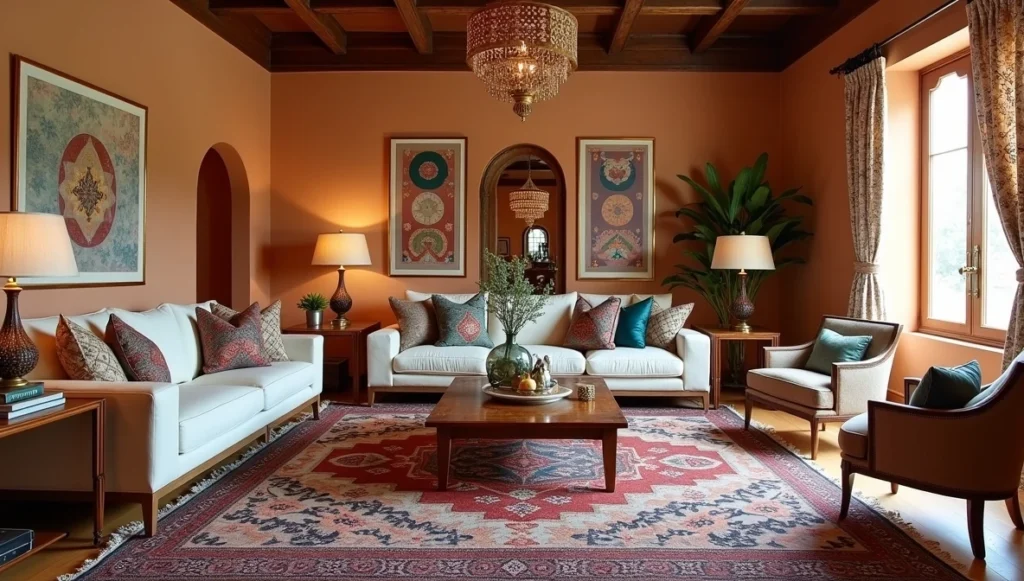
Room by Room Reality Check
Living Rooms for Actually Living
Low seating works great for conversation – people relax more when they’re not perched on formal furniture. Floor cushions, low sofas loaded with pillows, maybe a pouf or two.
Round coffee tables encourage people to gather around instead of facing one direction like you’re watching TV. Look for carved wood or brass tray tables.
Lanterns are non-negotiable. Hanging ones, table ones, floor ones – mix different sizes and metals. They create this amazing warm glow that makes everyone look better.
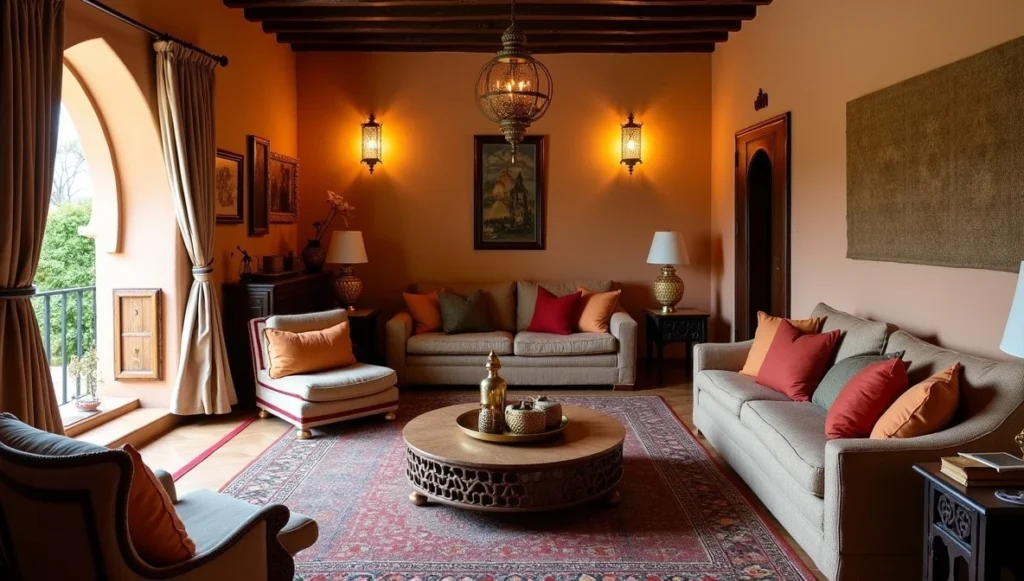
Bedrooms That Feel Special
Platform beds work perfectly with rich tapestries as headboards. Or go dramatic with carved wood if you want to make a statement.
Layer rugs like you’re creating a carpet sandwich. Small ones by the bed, bigger one under the furniture. It feels incredibly luxurious when you step out of bed.
Canopy beds with flowing curtains create instant romance without being too over the top. Even simple four-poster beds with sheer fabric work.

Dining Rooms for Feasting
Round tables are huge in Moroccan culture – everyone can see each other and share food easily. Pair with upholstered chairs in rich fabrics.
Display your serving pieces instead of hiding them. Brass tea glasses, ceramic tagines, hand-painted bowls – they’re art when they’re not being used.
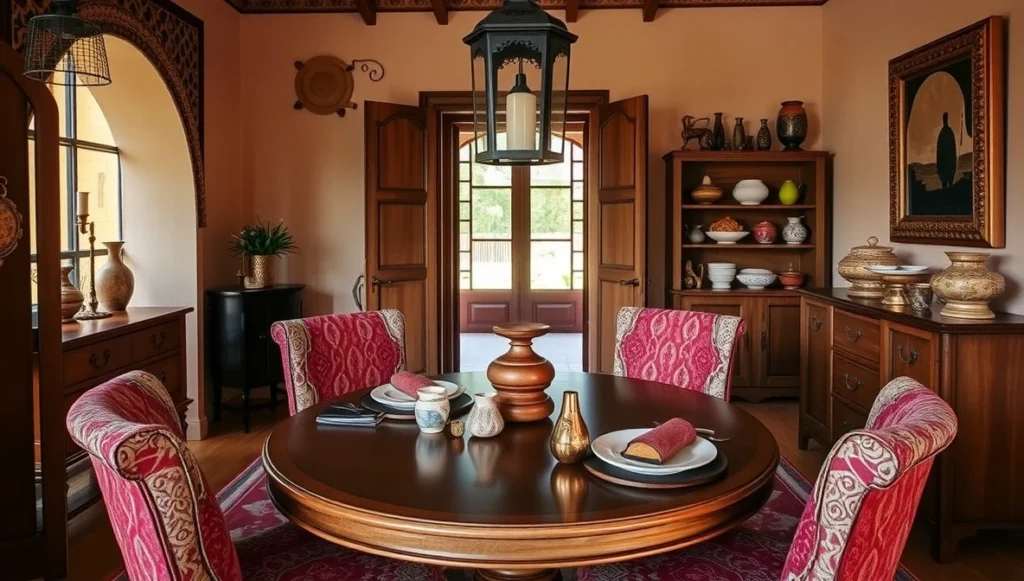
Kitchens with Personality
Zellige tiles (those handmade ones with slight imperfections) make incredible backsplashes. Each tile is a little different, so the whole surface feels alive.
Hang brass and copper pots where you can see them. They’re functional and look amazing. Add some preserved lemon jars and spice containers for authenticity.
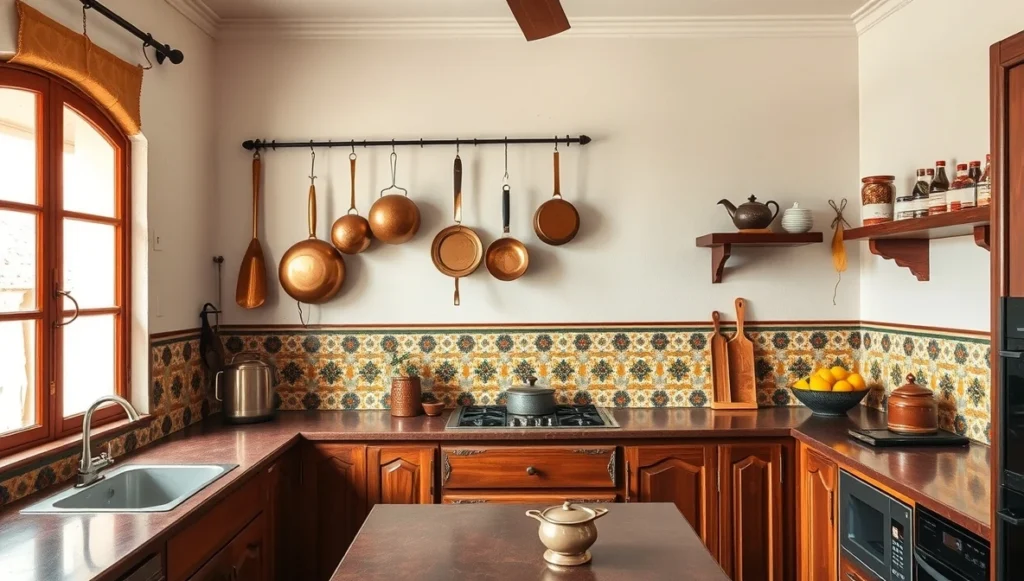
Bathrooms Like Private Spas
Brass fixtures in aged finishes look expensive without breaking the bank. Moroccan mirrors with metalwork frames make any bathroom feel special.
Tadelakt plaster walls are the ultimate luxury if you can swing it – smooth as soap and naturally waterproof. But good faux versions exist too.

Home Offices That Don’t Suck
Heavy wooden desk with some brass details – the weight and texture help you focus. Leather chair in cognac or brown that gets better with age.
Small Moroccan rug under your desk makes the space feel intentional. Brass desk lamp gives you warm light for late-night work sessions.
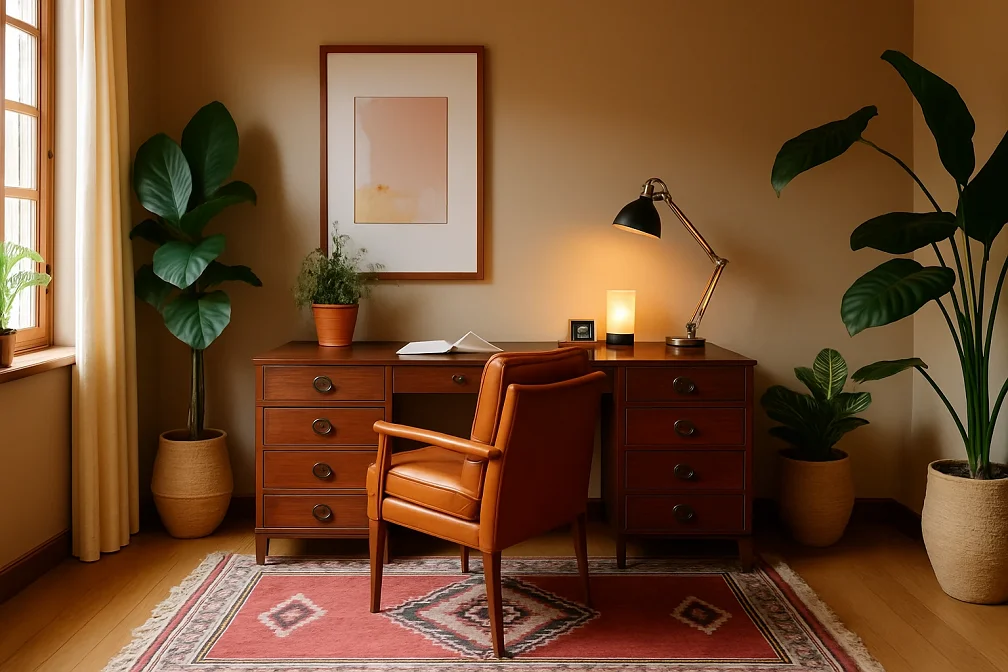
Entryways That Set the Mood
Carved console table with a brass lantern and ceramic bowl for keys. Small mosaic mirror above to check yourself before leaving.
Runner rug in warm colors, woven baskets for storage, wall sconce for soft lighting. Maybe a potted olive tree if you have good light.
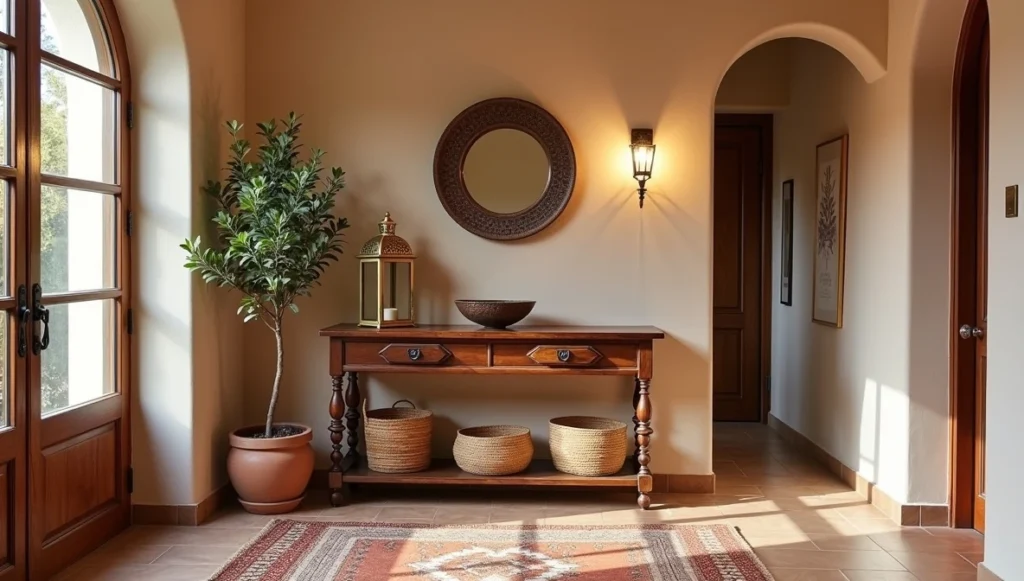
Textures Worth Touching
Rugs That Ground Everything Beni Ourain rugs (cream with black diamond patterns) are classics because they work with almost any color scheme. Vintage Moroccan rugs have amazing faded colors that look expensive.
Don’t be afraid to layer different rugs – it’s more authentic and way more comfortable underfoot.
Fabrics for Comfort Heavy cotton and linen for curtains and upholstery hold up better than delicate fabrics. Silk accents here and there for luxury touches.
Look for embroidered pieces with metallic thread – they catch light beautifully and add that handmade quality that makes everything feel special.
Metal and Ceramic Magic Start with brass pieces and let them develop patina naturally, or hunt vintage for character that’s already there. Hand-painted ceramics with slight imperfections beat machine-perfect every time.
Don’t Make These Mistakes
Going full Aladdin theme park. Mix in some neutral pieces so your house doesn’t look like a restaurant.
Ignoring lighting. Harsh overhead lights kill the whole vibe. You need warm, soft, layered lighting.
Buying everything online. This style depends on texture and handmade quality you can’t judge from photos. Touch things when possible.
Forgetting comfort. Authentic doesn’t mean uncomfortable. Make sure you can actually live in the space.
How to Start Without Going Broke
Get one amazing piece first – maybe a vintage rug or carved mirror. See how it changes your room’s energy before adding more.
Brass lighting makes the biggest impact for your money. One lantern or sconce transforms a space instantly.
Add textiles gradually – pillows, throws, maybe new curtains. You can experiment with color and pattern without huge commitment.
Accessories come last – ceramics, brass objects, plants in decorative pots. Build the layers slowly instead of buying everything at once.
Why This Actually Makes Life Better
Moroccan design creates rooms where you want to hang out. Everything invites you to sit down, relax, have a conversation. It’s the opposite of formal “don’t touch anything” decorating.
The handmade quality brings life into spaces that can feel too sterile and perfect. Even small touches – one brass bowl, textured throw pillow, carved wooden tray – add warmth and personality.
My clients who try this style say their homes feel more welcoming and their stress levels drop. There’s something about rich colors, soft lighting, and touchable textures that makes people naturally relax.
The best part? This style actually gets better with age and use. Brass develops patina, rugs get softer, wood gets more beautiful. Your home becomes more itself over time instead of looking shabby.
Start small, trust your gut, and remember – life’s too short for beige walls.
